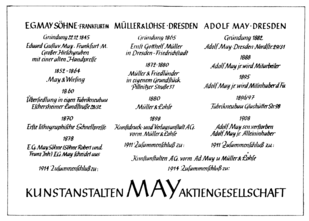Art institutions May
| Art institutions May | |
|---|---|
| legal form | AG |
| founding | 1914 |
| Seat | Dresden - Johannstadt , Saxony |
The art institutions May AG (KAMAG) is now in Aschaffenburg -based art publishing house . The "lithographic institute", which emerged in Dresden in 1914 from the merger of the Dresdner Kunstanstalten AG, founded by Adolf May in 1882, and the Frankfurt company EG May Söhne , has long been one of the largest German producers of popular printmaking.
Company history
From the very beginning, KAMAG was a global company that operated to a large extent outside of Europe. This included, among other things, the export of religious and profane wall decorations to British India , which were produced according to original templates made there. The company's authorized signatory, Friedrich Diefenbach, was instrumental in bringing about the Berne Convention for the Protection of Works of Literature and Art .
After the company had already started a trial program for the production of large-format murals , it acquired Hans Zatzka's painting “Elfenreigen” in 1914 . It was sold in the so-called towel format as a bedroom picture. Josef Untersberger's “Christ on the Mount of Olives” became a best seller in 1917 . In the following decade there was real competition in the industry for the bedroom picture article. KAMAG's toughest competitor at the time was the Berlin publisher Felix Freund . Adolf May tried in vain to enforce the copyright protection of image ideas and thus went to the Imperial Court (see Hans Zatzka). Foreign business was inhibited by the First World War, but flourished again in the interwar period.
A subsidiary of KAMAG, Arthur Kolbe GmbH , offered elaborate erotic collotype prints that did not fit into the parent company's publishing program. The National Socialist art policy that took effect from 1933 influenced the range of goods selectively; With collotype prints in normal image format, the so-called Sartos prints, the company brought out a "higher quality" series. Here the landscape and children's image predominated. The old Kolbe printing machines are in the Dresden collotype workshop , a museum.
After the war, the Soviet zone administration nationalized the production facilities. The previous owners and main shareholders as well as the leading employees moved to the West and in 1949 moved the company headquarters to Fürth . In the 1960s, the sarto body and the "art sheets" came back to life. In the 1970s, the company was still exporting "Heliochrom" bedroom pictures outside of Central Europe.
Today the company is based in Aschaffenburg.
literature
- Wolfgang Brückner : Petty bourgeois and affluent bourgeois wall decorations in the 20th century. In art and consumption - mass image research (= folklore as historical cultural studies 6; publications on folklore and cultural history 82). Pp. 407-444. Wuerzburg 2000
- Wolfgang Brückner, Christa Pieske : The picture factory. Documentation on the art and social history of industrial wall decoration production between 1845 and 1973 using the example of a large company. Historical Museum Frankfurt am Main, Frankfurt 1973
- Wolfgang Brückner: Elfenreigen, wedding dream. The oil pressure production 1880–1940. DuMont Schauberg, Cologne 1974, ISBN 3-7701-0762-4
Web links
- Web presence of May Kunstblattverlag, Aschaffenburg
- Early documents and newspaper articles on the May art institutions in the 20th century press kit of the ZBW - Leibniz Information Center for Economics .
Individual evidence
- ^ Therese Pechstein: Indian color prints of the Kunstanstalten May AG Dresden. In the Bild Druck Papier working group - conference proceedings Ittingen 2004. pp. 129–134. Waxmann 2005, ISBN 978-3-8309-1519-5 ( website of the exhibition )



